Search Result
Results for "
T-cell response
" in MedChemExpress (MCE) Product Catalog:
1
Biochemical Assay Reagents
| Cat. No. |
Product Name |
Target |
Research Areas |
Chemical Structure |
-
- HY-11062
-
|
AG-3-5
|
TRP Channel
|
Neurological Disease
Inflammation/Immunology
|
|
Icilin (AG-3-5) is a super-agonist of the transient receptor potential M8 (TRPM8) ion channel. Icilin activates TRPM8 in EGTA in a dose-dependent manner (EC50=1.4 μM). Icilin is a “super-cooling agent” . Icilin attenuates autoimmune neuroinflammation through modulation of the T-cell response .
|
-
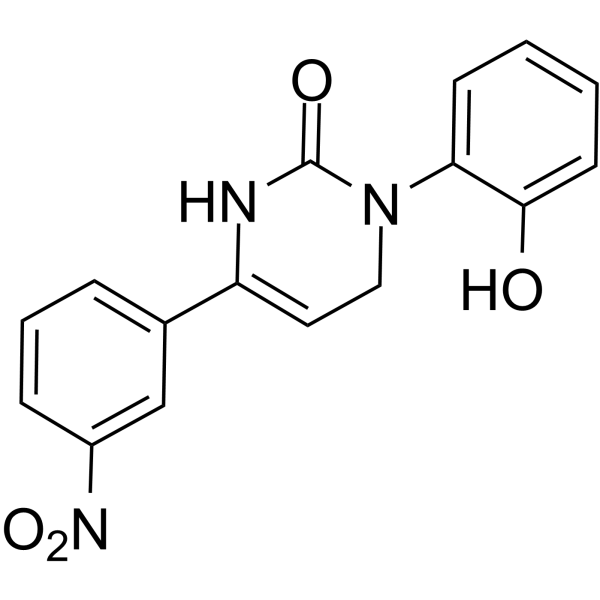
-
- HY-P99048
-
|
IBI308
|
PD-1/PD-L1
|
Inflammation/Immunology
Cancer
|
|
Sintilimab (IBI308) is a fully human IgG4 monoclonal antibody that binds to PD-1, thereby blocking the interaction of PD-1 with its ligands (PD-L1 and PL-L2) and consequently helping to restore the endogenous antitumour T-cell response. Sintilimab can be used for the research of classical Hodgkin's lymphoma, non-small cell lung cancer and oesophageal cancer .
|
-
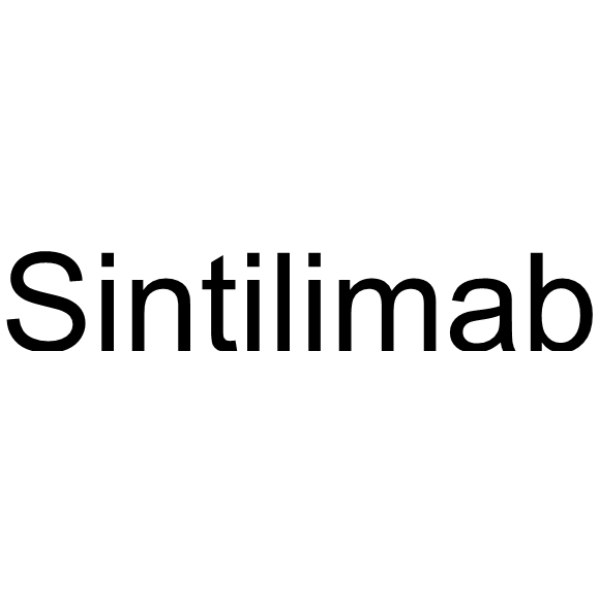
-
- HY-121662
-
|
LDK
|
Apoptosis
|
Inflammation/Immunology
Cancer
|
|
Lenaldekar (LDK) inhibits human and murine T-cell expansiomn. Lenaldekar inhibits autoimmune T cell response. Lenaldekar also induces cancer cell apoptosis. Lenaldekar can be used for T-cell mediated autoimmune diseases research .
|
-
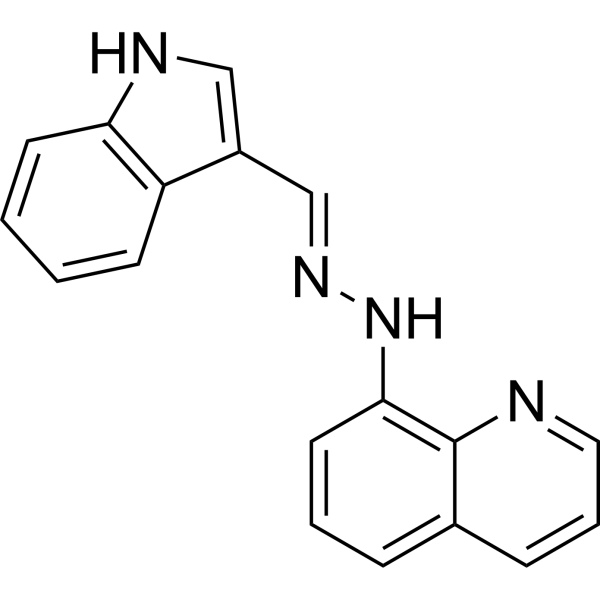
-
- HY-134950
-
|
|
TNF Receptor
|
Inflammation/Immunology
|
|
(E)-C-HDMAPP ammonium, is a potent phosphoantigen in ammonium form as well as a pyrophosphonate form of (E)-HDMAPP. (E)-C-HDMAPP is also an effective activator of γδ-T cells, induces T-cell stimulatory responses in vitro (EC50=0.91 nM for TNF-α release) .
|
-

-
- HY-P2561
-
|
|
Influenza Virus
|
Infection
Inflammation/Immunology
|
|
Influenza Matrix Protein (61-72) is a peptide fragment derived from matrix protein of influenza viruses, corresponds to amino acids 61-72. Influenza Matrix Protein (61-72) is a specific epitope which can induce CD4 + T-cell response .
|
-

-
- HY-P2560
-
|
|
Arenavirus
|
Infection
Inflammation/Immunology
|
|
LCMV GP (61-80) is a peptide fragment derived from lymphocytic choriomeningitis virus (LCMV) glycoprotein (GP), and corresponds to amino acids 61-80. LCMV GP (61-80) is a specific epitope which can induce CD4 + T-cell response .
|
-
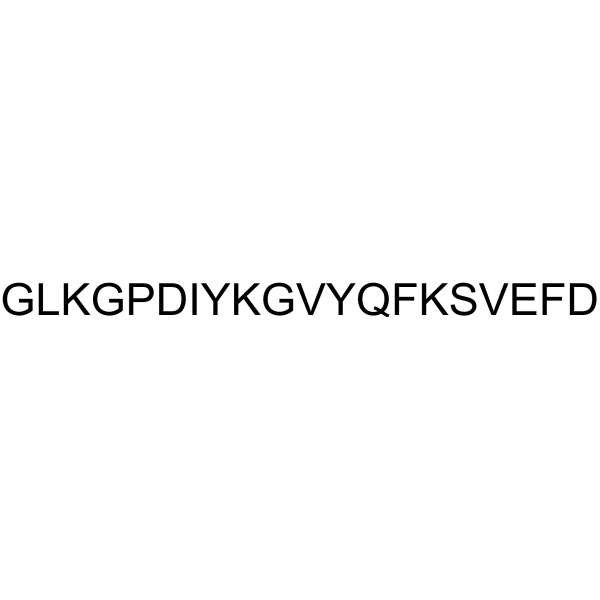
-
- HY-P99714
-
|
MGD019
|
PD-1/PD-L1
CTLA-4
|
Cancer
|
|
Lorigerlimab (MGD019) is a bispecific IgG4 dual-affinity re-targeting antibody (DART). Lorigerlimab can block PD-1 and CTLA-4, and improves T-cell responses. Lorigerlimab can be used for research of metastatic castration-resistant prostate cancer (mCRPC) .
|
-
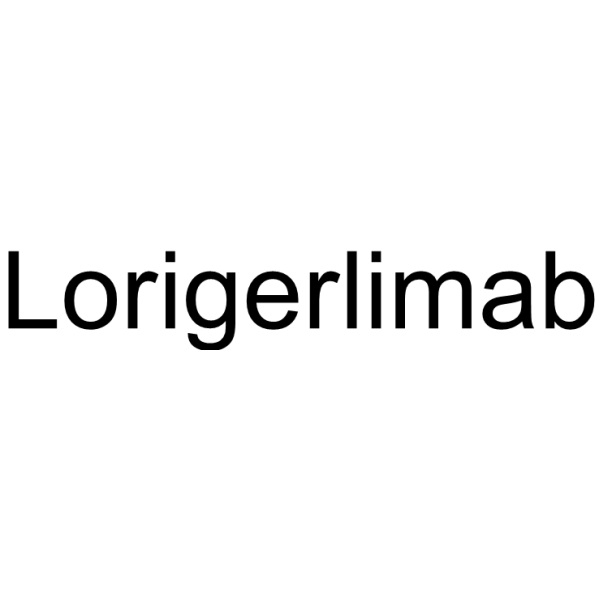
-
- HY-121508
-
|
|
NF-κB
|
Inflammation/Immunology
Cancer
|
|
(E/Z)-IT-603 is a mixture of E-IT-603 and Z-IT-603 (IT-603). IT-603 is a c-Rel inhibitor with an IC50 of 3 μM. IT-603 has anti-tumor activity. (E/Z)-IT-603 is a promising modulator of T-cell responses in the context of graft-versus-host disease (GVHD) and malignant diseases .
|
-
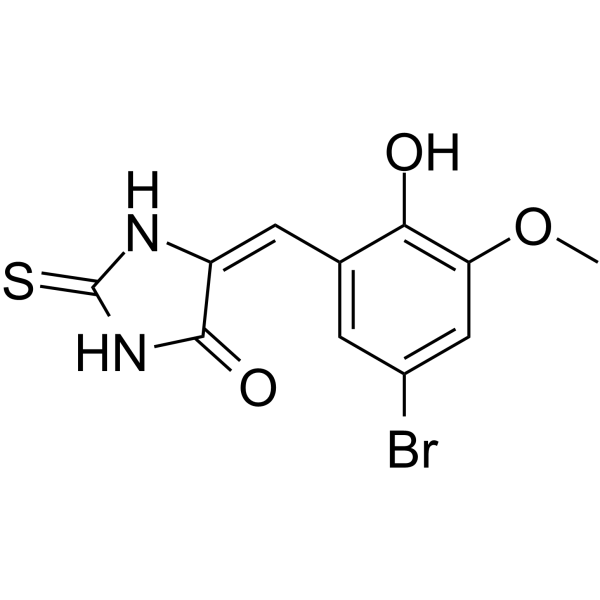
-
- HY-P5930
-
|
MDM2 32-46
|
Ligands for E3 Ligase
|
Cancer
|
|
HOXB7 8–25 (MDM2 32-46) is an MDM2-derived peptide epitope and can elicit antigen-specifc and tumor-reactive CD4 + T cell responses .
|
-
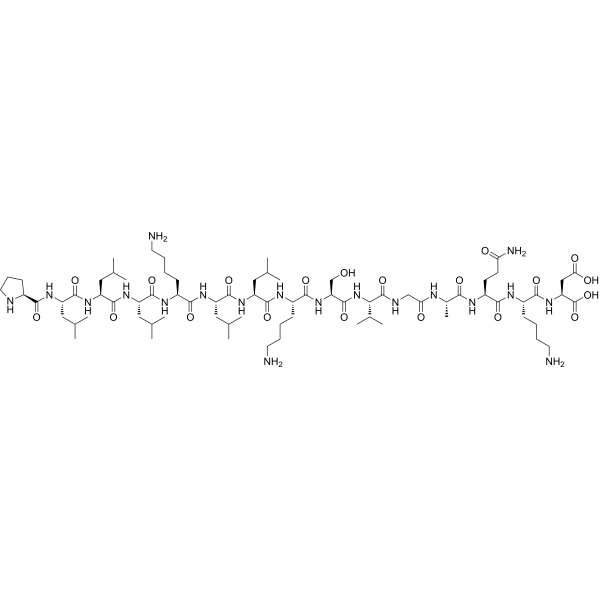
-
- HY-P99259
-
|
FPA 008; Anti-Human CSF1R Recombinant Antibody
|
c-Fms
|
Inflammation/Immunology
Cancer
|
|
Cabiralizumab (FPA 008) is an anti-CSF1R monoclonal antibody (MAb). Cabiralizumab enhances T cell infiltration and antitumor T cell immune responses. Cabiralizumab inhibits the activation of osteoclasts and blocks bone destruction, and can be used in the research of rheumatoid arthritis (RA). Cabiralizumab can combine with Nivolumab (HY-P9903) for lung cancer research .
|
-

-
- HY-148494
-
|
FLX475
|
CCR
|
Cancer
|
|
Tivumecirnon (FLX475) is an orally active CCR4 antagonist that blocks regulatory T cells from entering the tumor microenvironment, thereby reducing their interference with effective anti-tumor immune responses. Tivumecirnon has antitumor activity .
|
-
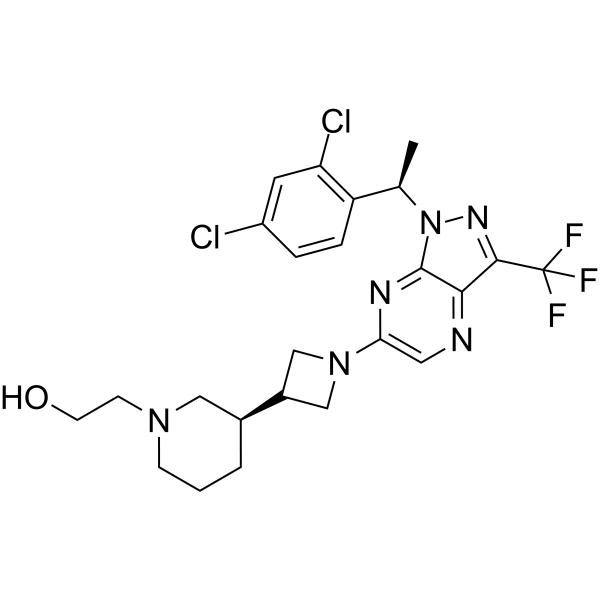
-
- HY-P99573
-
|
MGD-013
|
LAG-3
|
Inflammation/Immunology
Cancer
|
|
Tebotelimab (MGD-013) is a humanized IgG4κ bispecific PD-1/LAG-3 dual-affinity re-targeting (DART) antibody. Tebotelimab binds cell-surface expressed PD-1 and LAG-3 with EC50s of 1.65 nM and 0.41 nM in NS0 cells, respectively. Tebotelimab blocks PD-1/PD-L1, PD-1/PD-L2 and LAG-3/HLA (MHC-II) interactions and PD-1 signaling. Tebotelimab restores exhausted T-cell responses and and enhances antitumour immunity .
|
-
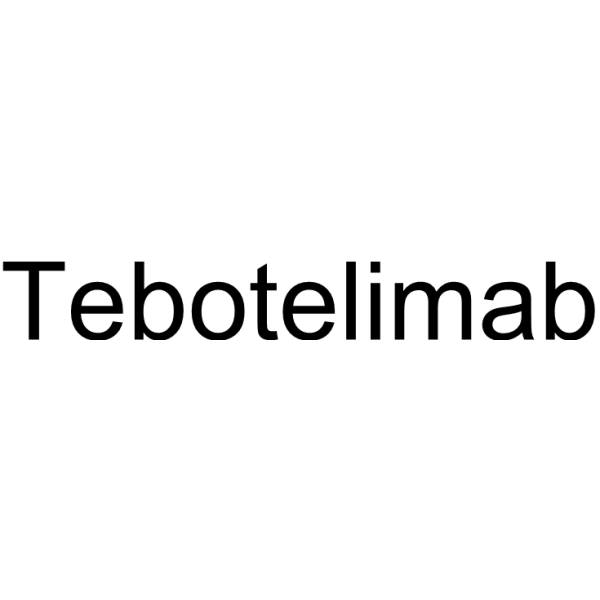
-
- HY-P3410
-
|
|
SHP2
Phosphatase
|
Inflammation/Immunology
|
|
Trichomide A is a potent activator of SHP2. Trichomide A is a natural cyclodepsipeptide. Trichomide A displays immunosuppressive activity against activated T lymphocyte–mediated immune responses in Con A-activated T cells. Trichomide A have the potential for the research of immune-related skin diseases .
|
-

-
- HY-137640A
-
|
|
PKA
|
Inflammation/Immunology
|
|
Sp-8-Br-cAMPS sodium is a cAMP analog, which performs a protein kinase A (PKA) activating activity with EC50 of 360 nM. Sp-8-Br-cAMPS sodium inhibits proliferation of T cells and the haemocyte non-self response in Lepidoptera larve .
|
-
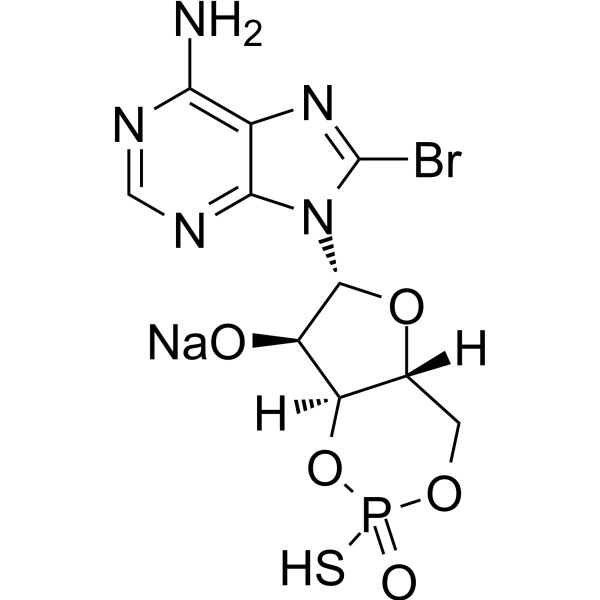
-
- HY-144088
-
|
HPK1-IN-22
|
MAP4K
|
Inflammation/Immunology
Cancer
|
|
ZYF0033 is effective in inhibiting hematopoietic progenitor cells HPK1, basically inhibiting MBP protein oxidation IC50 10 nM . ZYF0033 promotes anti-cancer immune response, lowers SLP76 (acid 376) oxidation. ZYF0033 Suppression 4T-1 Small mouse model with the same underlying cause, medium bulge growth length expansion DC, NK 细细和 CD107a + CD8 + T Cells, PD-1 +CD8 + T Cells, TIM-3 +CD8 + T Cells LAG3< sup>+CD8 + T Cellular immersion decreases.
|
-

-
- HY-149874
-
|
|
DGK
|
Inflammation/Immunology
|
|
BMS-502 (Compound 22) is a potent dual inhibitor of diacylglycerol kinase (DGK) α and ζ with IC50 of 4.6 nM and 2.1 nM. BMS-502 enhanced T cell immune responses in mice. BMS-502 can be used in tumor immunity related research .
|
-
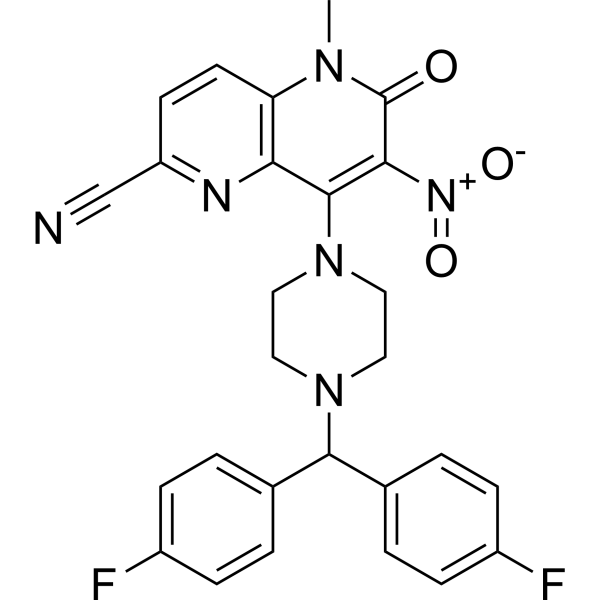
-
- HY-P5937
-
|
|
Apoptosis
|
Cancer
|
|
Caerin 1.1 TFA is a host defense peptide isolated from the glandular secretions of the Australian tree frog Litoria. Caerin 1.1 TFA inhibits HeLa cell proliferation and mediates apoptosis. Caerin 1.1 TFA may enhance adaptive T cell immune responses .
|
-
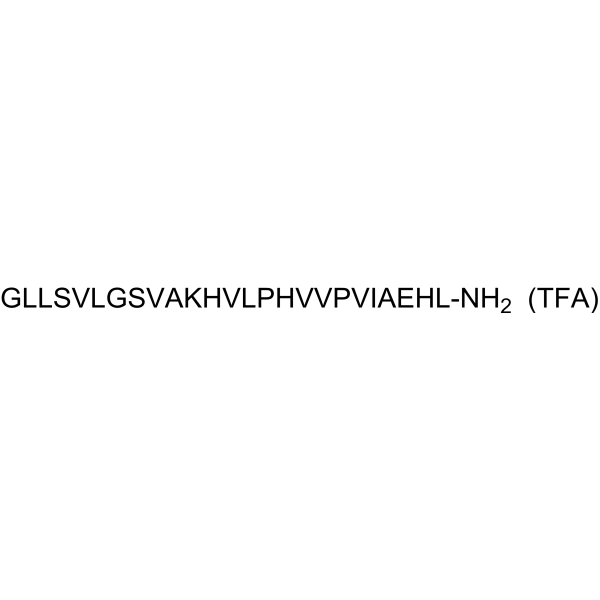
-
- HY-149213
-
|
|
Histone Demethylase
PD-1/PD-L1
|
Cancer
|
|
LSD1-IN-24(compound 3S) is a selective LSD1 inhibitor with IC50 = 0.247 μM. LSD1-IN-24 can mediate the expression of PD-L1, enhance T cell killing response, and can be used in cancer research .
|
-
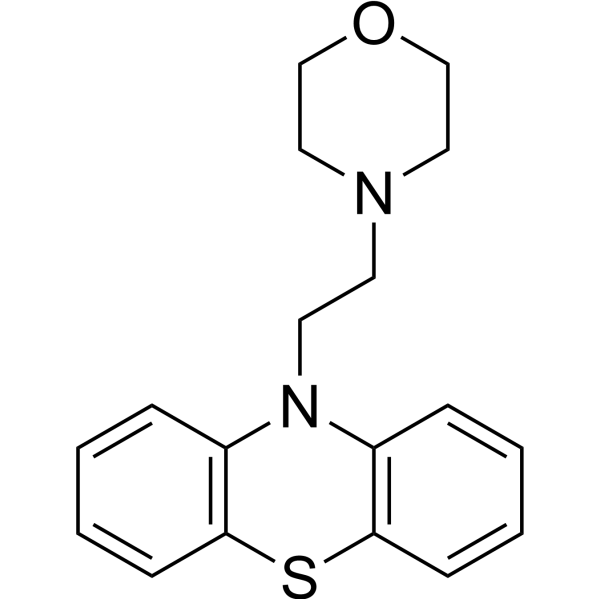
-
- HY-P4046
-
|
|
HIV
|
Inflammation/Immunology
|
|
HBV Seq2 aa:179-186 serve as effective motifs for CTL response in H-2b system after in vitro restimulation of the primed T cells. HBV Seq2 aa:179-186 is a novel epitope identified on the surface antigen of hepatitis B virus .
|
-
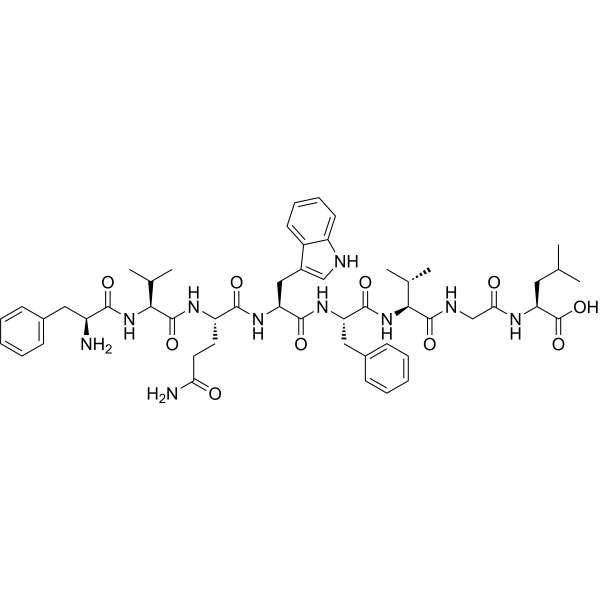
-
- HY-102090
-
|
|
CD28
|
Inflammation/Immunology
|
|
B7/CD28 interaction inhibitor 1 (copmound 6b) is a potent B7.1-CD28 interaction inhibitor with an IC50 of 50 nM .
|
-
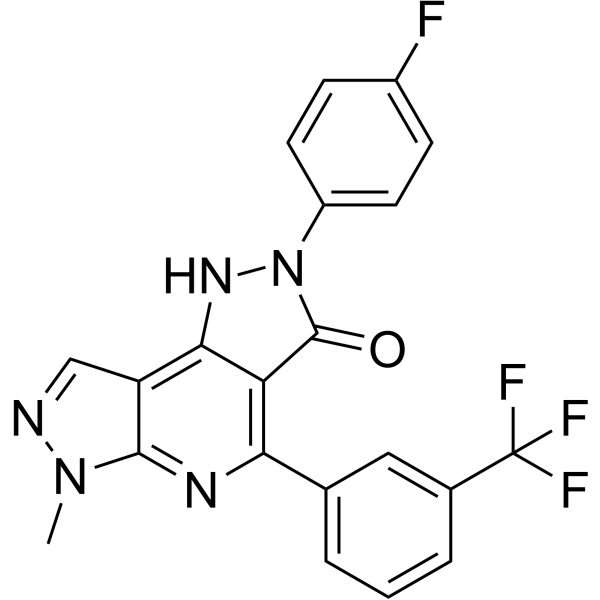
-
- HY-153808A
-
|
Montanide ISA-51
|
Others
|
Inflammation/Immunology
|
|
Incomplete Freund's adjuvant (IFA) (Montanide ISA-51) is an immunoadjuvant emulsified with antigen by its discoverer Jules T. Freund. Incomplete Freund's adjuvant (IFA) does not contain inactivated tuberculosis bacilli and consists of petroleum jelly containing lanolin. Incomplete Freund's adjuvant (IFA) induces high antibody titers and long-lasting effector T cell responses with no long-term effects on collagen disease, tumors, or death. Complete Freund's adjuvant (CFA) (HY-153808) is another type of Freund's Adjuvant that stimulates a stronger immune response .
|
-

-
- HY-142938
-
|
|
ROR
|
Inflammation/Immunology
|
|
RORγt agonist 3 is a potent agonist of RORγt. RORγt agonist 3 promotes the differentiation of Th17 cells and enhances the levels of pro-inflammatory cytokines, thereby increasing the cytotoxicity of lymphocytes. RORγt agonist 3 inhibits the production of regulatory T cells, which suppresses the immune response (extracted from patent WO2021136326A1, compound 23) .
|
-
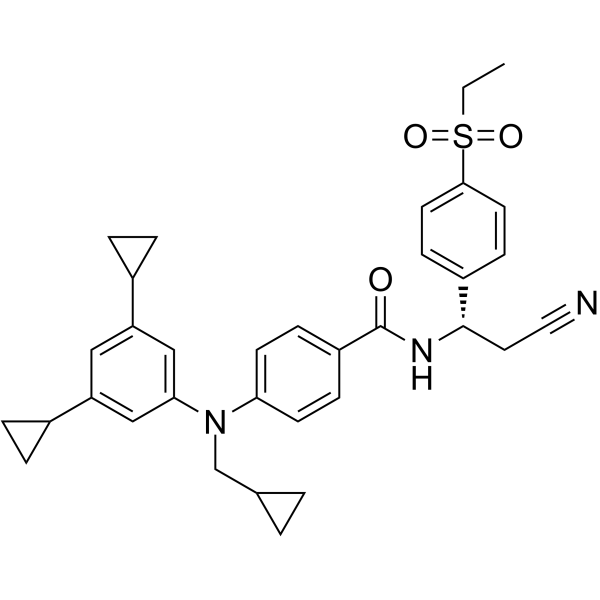
-
- HY-142937
-
|
|
ROR
|
Inflammation/Immunology
|
|
RORγt agonist 2 is a potent agonist of RORγt. RORγt agonist 2 promotes the differentiation of Th17 cells and enhances the levels of pro-inflammatory cytokines, thereby increasing the cytotoxicity of lymphocytes. RORγt agonist 2 inhibits the production of regulatory T cells, which suppresses the immune response (extracted from patent WO2021136339A1, compound 17) .
|
-

-
- HY-130116A
-
|
|
STING
|
Cancer
|
|
IACS-8779 disodium is a highly potent stimulator of interferon genes (STING) agonist with robust systemic antitumor efficacy. IACS-8779 disodium shows robust activation of the STING pathway in vitro and a superior systemic anti-tumor response in the B16 murine model of melanoma .
|
-
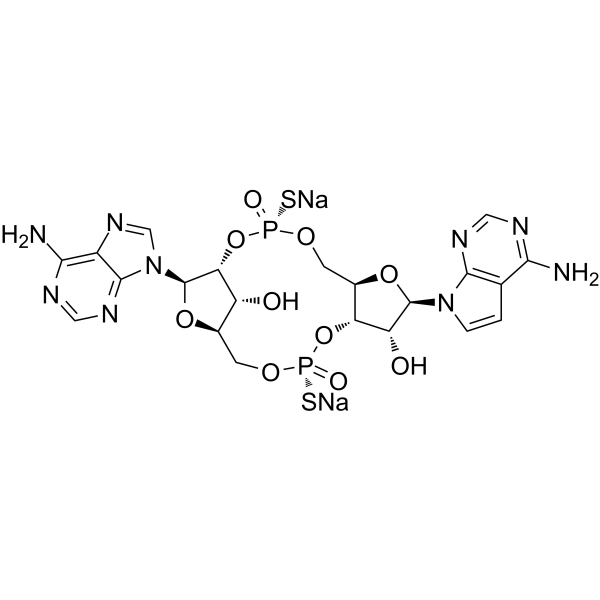
-
- HY-W145657
-
|
Cord Factor
|
Biochemical Assay Reagents
|
Infection
|
|
Trehalose 6,6'-dimycolate (Cord Factor) is trehalose 6,6'-dimycolate, a cell wall glycolipid of Mycobacterium tuberculosis, which can be used to simulate inflammation and granuloma induced by Mycobacterium tuberculosis (MTB) form. Trehalose 6,6′-dimycolate also protects Mycobacterium tuberculosis from macrophage-mediated killing, inhibits efficient antigen presentation, and reduces the development of protective T cell responses .
|
-
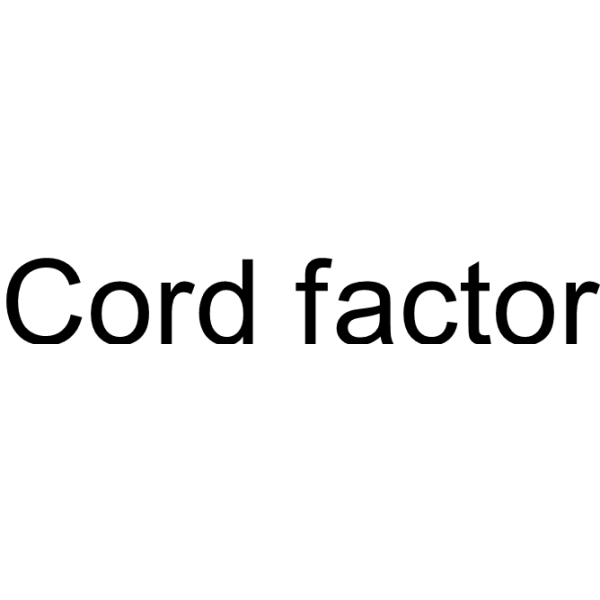
-
- HY-155115
-
|
|
Histone Demethylase
PD-1/PD-L1
|
Cancer
|
|
LSD1-IN-27 (Compound 5ac) is a LSD1 inhibitor (IC50: 13 nM). LSD1-IN-27 inhibits the stemness and migration of gastric cancer cells. LSD1-IN-27 also reduces the expression of PD-L1 in BGC-823 and MFC cells. LSD1-IN-27 can enhance T cell immune response in gastric cancer .
|
-

-
- HY-101092
-
|
Stimulon
|
|
|
|
QS-21, an immunostimulatory saponin, could be used as a potent vaccine adjuvant. QS-21 stimulates Th2 humoral and Th1 cell-mediated immune responses through action on antigen presenting cells (APCs) and T cells. QS-21 can activate the NLRP3 inflammasome with subsequent release of caspase-1 dependent cytokines, IL-1β and IL-18 .
|
-
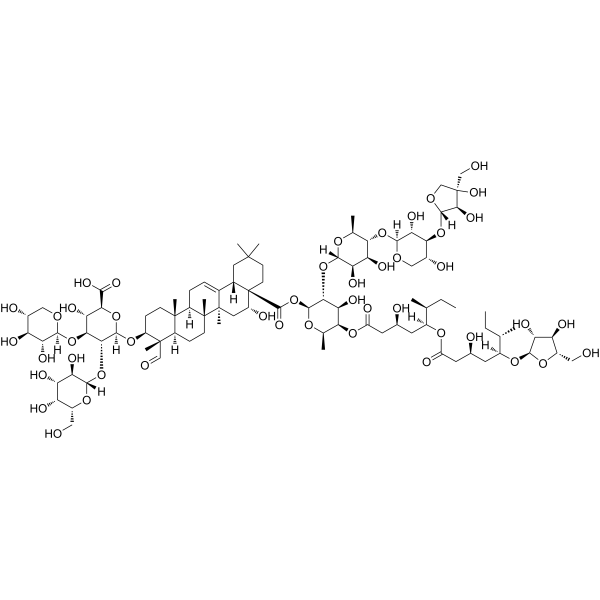
-
- HY-143869
-
|
|
MAP4K
|
Cancer
|
|
HPK1-IN-28 is a potent inhibitor of HPK1. Hematopoietic progenitor kinase 1 (HPK1) is a negative regulator of the activation response of dendritic cells (DCs), T cells and B cells. HPK1-IN-28 enhances the body's anti-tumor immunity. HPK1-IN-28 has the potential for the research of immune-related diseases, especially tumor (extracted from patent WO2021175270A1, compound 1) .
|
-
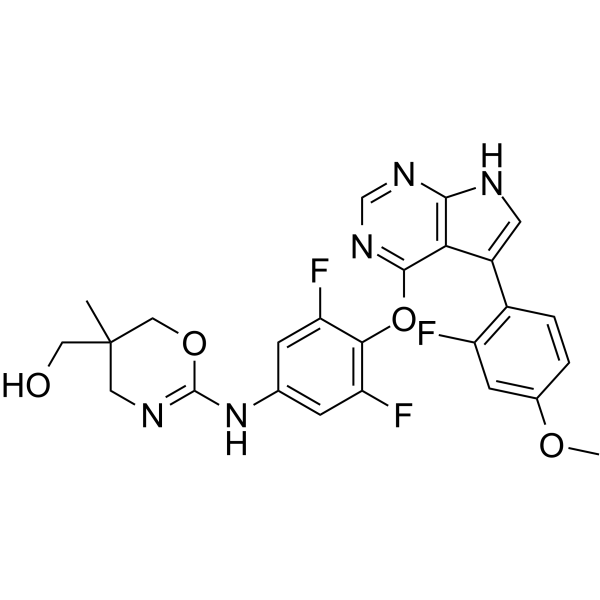
-
- HY-143870
-
|
|
MAP4K
|
Cancer
|
|
HPK1-IN-29 is a potent inhibitor of HPK1. Hematopoietic progenitor kinase 1 (HPK1) is a negative regulator of the activation response of dendritic cells (DCs), T cells and B cells. HPK1-IN-29 enhances the body's anti-tumor immunity. HPK1-IN-29 has the potential for the research of immune-related diseases, especially tumor (extracted from patent WO2021175270A1, compound 38) .
|
-

-
- HY-P1698
-
|
AB-103
|
Bacterial
CD28
|
Infection
Inflammation/Immunology
|
|
Reltecimod (AB-103) is a T-cell-specific surface glycoprotein CD28 (TP44) antagonist. Reltecimod has beneficial effects against different bacterial infections, their exotoxins and endotoxins, and ionizing radiation. Reltecimod modulates the inflammatory response by targeting and attenuating the critical CD28/B7-2 co-stimulatory pathway, without inhibiting it. Reltecimod can be used to research necrotizing soft-tissue infections (NSTIs) .
|
-

-
- HY-P99687
-
|
AMG 256
|
PD-1/PD-L1
|
Cancer
|
|
Latikafusp (AMG 256) is a bifunctional fusion protein comprising a PD-1-targeting antibody and IL-21 mutein designed to deliver IL-21 pathway stimulation to PD-1+ cells. Latikafusp is designed to prime and extend the activity of cytotoxic and memory T cells and induce anti-tumor immunity. Latikafusp has the potential for solid tumors research .Latikafusp may lead to the development of immunogenicity-mediated responses .
|
-

-
- HY-130625
-
|
|
PD-1/PD-L1
|
Inflammation/Immunology
Cancer
|
|
PD-1/PD-L1-IN 6 (compound A13) is a potent PD-1/PD-L1 interaction inhibitor, with an IC50 of 132.8 nM. PD-1/PD-L1-IN 6 exhibits outstanding immunoregulatory activity. PD-1/PD-L1-IN 6 significantly elevates interferon-γ secretion in a Hep3B/OS-8/hPD-L1 and CD3 T cell co-culture model, without significant toxic effect. PD-1/PD-L1-IN 6 restores the immune response in a T cell-tumor co-culture model .
|
-
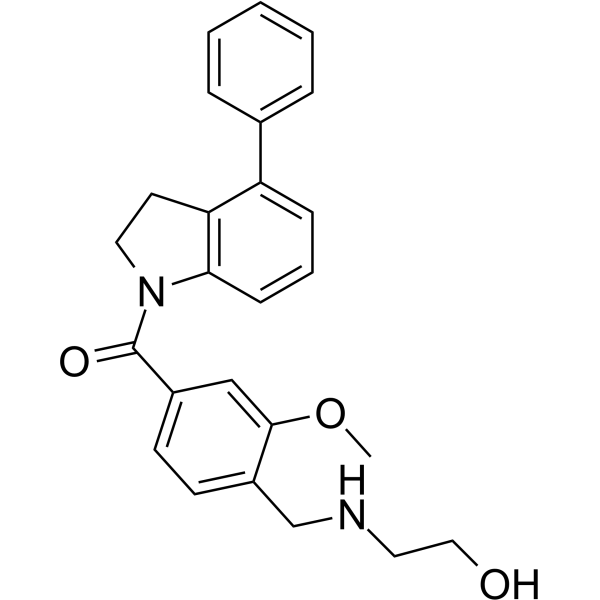
-
- HY-108391
-
|
N-Octanoyl-D-erythro-sphingosine
|
Apoptosis
PKC
Autophagy
|
Inflammation/Immunology
Cancer
|
|
C8-Ceramide (N-Octanoyl-D-erythro-sphingosine) is a cell-permeable analog of naturally occurring ceramides. C8-Ceramide has anti-proliferation properties and acts as a potent chemotherapeutic agent. C8-Ceramide stimulates dendritic cells to promote T cell responses upon virus infections. C8-Ceramide induces slight activation of protein kinase (PKC) in vitro .
|
-
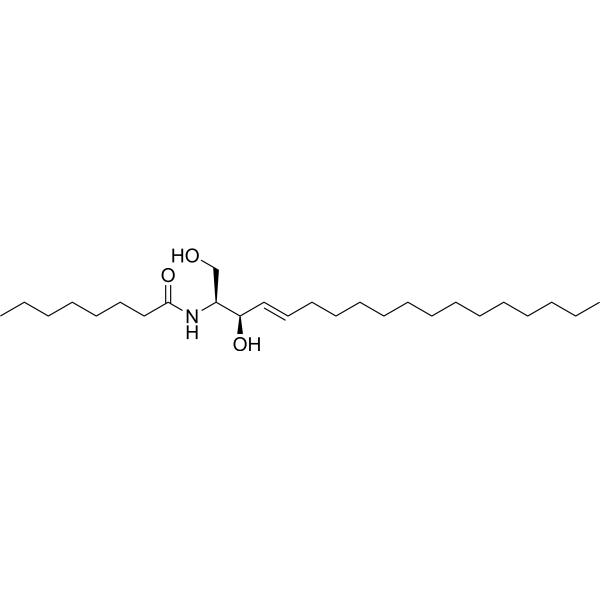
-
- HY-P1698B
-
|
AB-103 TFA
|
Bacterial
CD28
|
Infection
Inflammation/Immunology
|
|
Reltecimod (AB-103) TFA is a T-cell-specific surface glycoprotein CD28 (TP44) antagonist. Reltecimod TFA has beneficial effects against different bacterial infections, their exotoxins and endotoxins, and ionizing radiation. Reltecimod TFA modulates the inflammatory response by targeting and attenuating the critical CD28/B7-2 co-stimulatory pathway, without inhibiting it. Reltecimod TFA can be used to research necrotizing soft-tissue infections (NSTIs) .
|
-
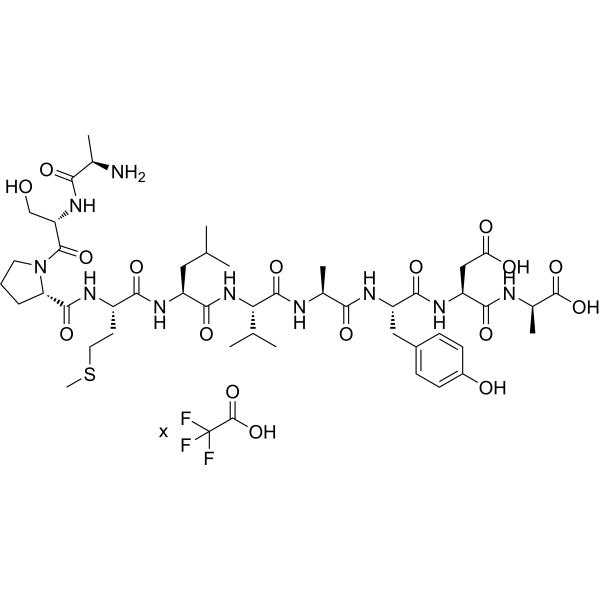
-
- HY-161255
-
|
|
NO Synthase
|
Inflammation/Immunology
|
|
3,4-DAA is an orally active Anthranilic acid derivative with potent immunosuppressive activities. 3, 4-DAA can alleviate the severity of colitis through inhibiting Th1 cells response, promoting Th2 cytokines expression and inducing CD4 +CD25 + T cells expression . 3,4-DAA suppressed expression of inducible nitric oxide synthase (iNOS) and nitric oxide (NO) release from EOC20 cells induced by IFN-γ and Lipopolysaccharide .
|
-

-
- HY-148029
-
|
TAK-676
|
STING
|
Cancer
|
|
Dazostinag disodium (TAK-676) is an agonist of STING, triggering the activation of STING signaling pathway and type I interferons. Dazostinag disodium is also a modulator of immune system, resulting complete regressions and durable memory T-cell immunity. Dazostinag disodium promotes durable IFN-dependent antitumor immunity .
|
-

-
- HY-119312
-
|
|
PKC
|
Cancer
|
|
C8 Dihydroceramide is a negative control of C8 Ceramide. C8-Ceramide (N-Octanoyl-D-erythro-sphingosine) is a cell-permeable analog of naturally occurring ceramides. C8-Ceramide has anti-proliferation properties and acts as a potent chemotherapeutic agent. C8-Ceramide stimulates dendritic cells to promote T cell responses upon virus infections. C8-Ceramide induces slight activation of protein kinase (PKC) in vitro .
|
-
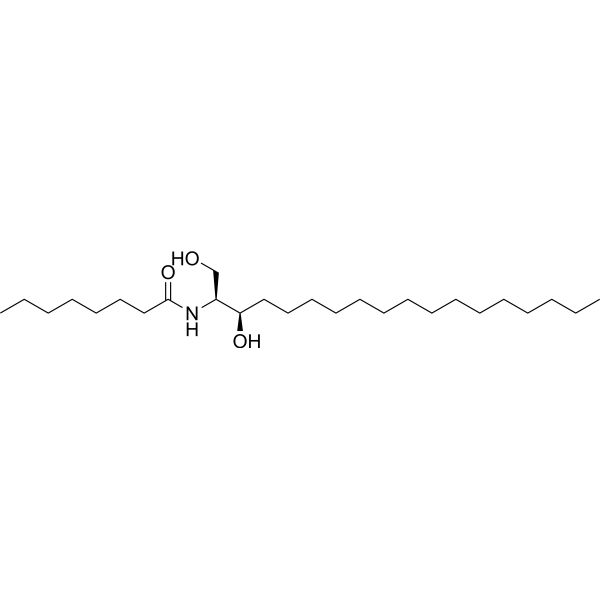
-
- HY-153128
-
|
|
DOCK
|
Inflammation/Immunology
|
|
DOCK2-IN-1 (compound 3), a CPYPP (HY-110100) analogue, is an inhibitor of DOCK2 as well (IC50=19.1 μM). DOCK2-IN-1 binds to DOCK2 DHR-2 domain in a reversible manner to inhibits its catalytic activity. DOCK2-IN-1 blocks the activation of both chemokine receptor- and antigen receptor-mediated Rac in lymphocytes. DOCK2-IN-1 significantly suppresses chemotactic response and T cell activation .
|
-
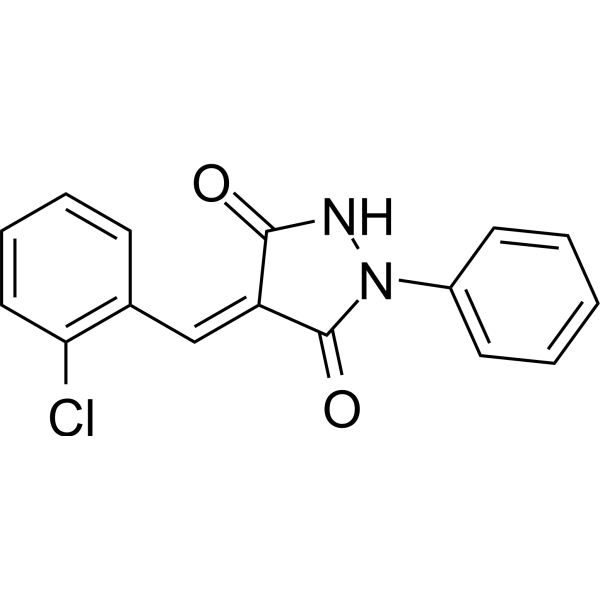
| Cat. No. |
Product Name |
Type |
-
- HY-W145657
-
|
Cord Factor
|
Biochemical Assay Reagents
|
|
Trehalose 6,6'-dimycolate (Cord Factor) is trehalose 6,6'-dimycolate, a cell wall glycolipid of Mycobacterium tuberculosis, which can be used to simulate inflammation and granuloma induced by Mycobacterium tuberculosis (MTB) form. Trehalose 6,6′-dimycolate also protects Mycobacterium tuberculosis from macrophage-mediated killing, inhibits efficient antigen presentation, and reduces the development of protective T cell responses .
|
| Cat. No. |
Product Name |
Target |
Research Area |
-
- HY-P2514
-
|
|
Peptides
|
Inflammation/Immunology
|
|
TET 830 modified/T-helper epitope from tetanus toxoid is a modified T-helper epitope from tetanus toxoid. TET 830 modified/T-helper epitope from tetanus toxoid induces T-cells responses and is used as a helper peptide in vaccinations .
|
-
- HY-P2560
-
|
|
Arenavirus
|
Infection
Inflammation/Immunology
|
|
LCMV GP (61-80) is a peptide fragment derived from lymphocytic choriomeningitis virus (LCMV) glycoprotein (GP), and corresponds to amino acids 61-80. LCMV GP (61-80) is a specific epitope which can induce CD4 + T-cell response .
|
-
- HY-P5425
-
|
|
Peptides
|
Others
|
|
Tetanus Toxin (830–844) is a biological active peptide. (tetanus toxin-derived peptide TT830–844 CD4+ T-cell epitope. This promiscuous CD4+ T-cell epitope can bind to a wide range of HLA–DRB molecules and is thus expected to activate CD4+ T-cell responses in a large part of the human population)
|
-
- HY-P2561
-
|
|
Influenza Virus
|
Infection
Inflammation/Immunology
|
|
Influenza Matrix Protein (61-72) is a peptide fragment derived from matrix protein of influenza viruses, corresponds to amino acids 61-72. Influenza Matrix Protein (61-72) is a specific epitope which can induce CD4 + T-cell response .
|
-
- HY-P4628
-
|
LRH-1 peptide
|
Peptides
|
Inflammation/Immunology
|
|
TPNQRQNVC is a nonapeptide and is the epitope of HLA-B0702. TPNQRQNVC induces a CD8+ T cell immune response .
|
-
- HY-P1089
-
|
PCC 88-104
|
Peptides
|
Inflammation/Immunology
|
|
Cytochrome c-pigeon (88-104) (PCC 88-104) has full stimulatory activity for pigeon cytochrome c-primed T cells from B10.A mice. The I-E k-restricted T cell response to Cytochrome c pigeon (pcyt c) is specific for the COOH-terminal sequence 88-104 .
|
-
- HY-P5930
-
|
MDM2 32-46
|
Ligands for E3 Ligase
|
Cancer
|
|
HOXB7 8–25 (MDM2 32-46) is an MDM2-derived peptide epitope and can elicit antigen-specifc and tumor-reactive CD4 + T cell responses .
|
-
- HY-P5396
-
|
|
Peptides
|
Others
|
|
GAD65 (524-543) is a biological active peptide. (This is amino acids 524 to 543 fragment of glutamic acid decarboxylase 65 (GAD65). It is one of the first fragments of this islet antigen to induce proliferative T cell responses in the non-obese diabetic (NOD) mouse model of spontaneous autoimmune diabetes. This peptide is a specific, possibly low affinity, stimulus for the spontaneously arising diabetogenic T cell clone BDC2.5. Immunization with p524–543 increases the susceptibility of the NOD mice to type 1 diabetes induced by the adoptive transfer of BDC2.5 T cells.)
|
-
- HY-P3410
-
|
|
SHP2
Phosphatase
|
Inflammation/Immunology
|
|
Trichomide A is a potent activator of SHP2. Trichomide A is a natural cyclodepsipeptide. Trichomide A displays immunosuppressive activity against activated T lymphocyte–mediated immune responses in Con A-activated T cells. Trichomide A have the potential for the research of immune-related skin diseases .
|
-
- HY-P5937
-
|
|
Apoptosis
|
Cancer
|
|
Caerin 1.1 TFA is a host defense peptide isolated from the glandular secretions of the Australian tree frog Litoria. Caerin 1.1 TFA inhibits HeLa cell proliferation and mediates apoptosis. Caerin 1.1 TFA may enhance adaptive T cell immune responses .
|
-
- HY-P4046
-
|
|
HIV
|
Inflammation/Immunology
|
|
HBV Seq2 aa:179-186 serve as effective motifs for CTL response in H-2b system after in vitro restimulation of the primed T cells. HBV Seq2 aa:179-186 is a novel epitope identified on the surface antigen of hepatitis B virus .
|
-
- HY-P1698
-
|
AB-103
|
Bacterial
CD28
|
Infection
Inflammation/Immunology
|
|
Reltecimod (AB-103) is a T-cell-specific surface glycoprotein CD28 (TP44) antagonist. Reltecimod has beneficial effects against different bacterial infections, their exotoxins and endotoxins, and ionizing radiation. Reltecimod modulates the inflammatory response by targeting and attenuating the critical CD28/B7-2 co-stimulatory pathway, without inhibiting it. Reltecimod can be used to research necrotizing soft-tissue infections (NSTIs) .
|
-
- HY-113893
-
|
|
Peptides
|
Inflammation/Immunology
|
|
β-Interleukin I (163-171), human, an immunostimulatory fragment of human IL-1β peptide, is a T cell activator. β-Interleukin I (163-171), human is not an IL-1R-binding domain of IL-1β. β-Interleukin I (163-171), human is a potent adjuvant that enhances the immune response in a variety of exptl. situations .
|
-
- HY-P3718
-
-
- HY-P1698B
-
|
AB-103 TFA
|
Bacterial
CD28
|
Infection
Inflammation/Immunology
|
|
Reltecimod (AB-103) TFA is a T-cell-specific surface glycoprotein CD28 (TP44) antagonist. Reltecimod TFA has beneficial effects against different bacterial infections, their exotoxins and endotoxins, and ionizing radiation. Reltecimod TFA modulates the inflammatory response by targeting and attenuating the critical CD28/B7-2 co-stimulatory pathway, without inhibiting it. Reltecimod TFA can be used to research necrotizing soft-tissue infections (NSTIs) .
|
-
- HY-P5448
-
|
|
Peptides
|
Others
|
|
MOG (92–106), mouse, rat is a biological active peptide. (This is amino acids 92 to 106 fragment of the myelin oligodendrocyte glycoprotein (MOG) from mouse/rat. Mice with MOG (92–106)-induced experimental autoimmune encephalomyelitis develop extensive B cell reactivity against secondary myelin antigens. Despite the fact that this MOG peptide induces only weak T cell responses, MOG-induced autoimmunity is very severe. This peptide is encephalitogenic in SJL mice, DA rats, and rhesus monkeys.)
|
-
- HY-P1240
-
|
MOG (35-55)
|
Peptides
|
Neurological Disease
Inflammation/Immunology
|
|
Myelin Oligodendrocyte Glycoprotein Peptide (35-55), mouse, rat (MOG (35-55)) is a minor component of CNS myelin. Myelin Oligodendrocyte Glycoprotein Peptide (35-55), mouse, rat has encephalitogenic activity and induces T cell proliferative. Myelin Oligodendrocyte Glycoprotein Peptide (35-55), mouse, rat induces Th1 cytokine response as well as relatively high levels of IgG antibodies. Myelin Oligodendrocyte Glycoprotein Peptide (35-55), mouse, rat produces a relapsing-remitting neurological disease with extensive plaque-like demyelination .
|
-
- HY-P1240B
-
|
MOG (35-55) (acetate)
|
Peptides
|
Neurological Disease
Inflammation/Immunology
|
|
Myelin Oligodendrocyte Glycoprotein Peptide (35-55), mouse, rat (MOG (35-55)) acetate is a minor component of CNS myelin. Myelin Oligodendrocyte Glycoprotein Peptide (35-55), mouse, rat acetate has encephalitogenic activity and induces T cell proliferative. Myelin Oligodendrocyte Glycoprotein Peptide (35-55), mouse, rat acetate induces Th1 cytokine response as well as relatively high levels of IgG antibodies. Myelin Oligodendrocyte Glycoprotein Peptide (35-55), mouse, rat acetate produces a relapsing-remitting neurological disease with extensive plaque-like demyelination .
|
-
- HY-P1240A
-
|
MOG (35-55) (TFA)
|
Peptides
|
Neurological Disease
Inflammation/Immunology
|
|
Myelin Oligodendrocyte Glycoprotein Peptide (35-55), mouse, rat (MOG (35-55)) TFA is a minor component of CNS myelin. Myelin Oligodendrocyte Glycoprotein Peptide (35-55), mouse, rat TFA has encephalitogenic activity and induces T cell proliferative. Myelin Oligodendrocyte Glycoprotein Peptide (35-55), mouse, rat TFA induces Th1 cytokine response as well as relatively high levels of IgG antibodies. Myelin Oligodendrocyte Glycoprotein Peptide (35-55), mouse, rat TFA produces a relapsing-remitting neurological disease with extensive plaque-like demyelination .
|
| Cat. No. |
Product Name |
Target |
Research Area |
-
- HY-P99048
-
|
IBI308
|
PD-1/PD-L1
|
Inflammation/Immunology
Cancer
|
|
Sintilimab (IBI308) is a fully human IgG4 monoclonal antibody that binds to PD-1, thereby blocking the interaction of PD-1 with its ligands (PD-L1 and PL-L2) and consequently helping to restore the endogenous antitumour T-cell response. Sintilimab can be used for the research of classical Hodgkin's lymphoma, non-small cell lung cancer and oesophageal cancer .
|
-
- HY-P99431
-
|
Alomfilimab; SAR 445256
|
Inhibitory Antibodies
|
Inflammation/Immunology
Cancer
|
|
KY-1044 (Alomfilimab; SAR 445256) is a fully human IgG1 antibody targeting inducible costimulatory receptor (ICOS). KY-1044 depletes ICOS high cells via antibody-dependent cellular cytotoxicity (ADCC) through the engagement of FcgRIIIa. KY-1044 act as a costimulatory molecule on cells expressing lower ICOS levels, such as CD8 + TEff cells (through FcgR-dependent clustering). KY-1044 exploit the differential expression of ICOS on T-cell subtypes to improve the intratumoral immune contexture and restore an antitumor immune response .
|
-
- HY-P99259
-
|
FPA 008; Anti-Human CSF1R Recombinant Antibody
|
c-Fms
|
Inflammation/Immunology
Cancer
|
|
Cabiralizumab (FPA 008) is an anti-CSF1R monoclonal antibody (MAb). Cabiralizumab enhances T cell infiltration and antitumor T cell immune responses. Cabiralizumab inhibits the activation of osteoclasts and blocks bone destruction, and can be used in the research of rheumatoid arthritis (RA). Cabiralizumab can combine with Nivolumab (HY-P9903) for lung cancer research .
|
-
- HY-P99573
-
|
MGD-013
|
LAG-3
|
Inflammation/Immunology
Cancer
|
|
Tebotelimab (MGD-013) is a humanized IgG4κ bispecific PD-1/LAG-3 dual-affinity re-targeting (DART) antibody. Tebotelimab binds cell-surface expressed PD-1 and LAG-3 with EC50s of 1.65 nM and 0.41 nM in NS0 cells, respectively. Tebotelimab blocks PD-1/PD-L1, PD-1/PD-L2 and LAG-3/HLA (MHC-II) interactions and PD-1 signaling. Tebotelimab restores exhausted T-cell responses and and enhances antitumour immunity .
|
-
- HY-P99714
-
|
MGD019
|
PD-1/PD-L1
CTLA-4
|
Cancer
|
|
Lorigerlimab (MGD019) is a bispecific IgG4 dual-affinity re-targeting antibody (DART). Lorigerlimab can block PD-1 and CTLA-4, and improves T-cell responses. Lorigerlimab can be used for research of metastatic castration-resistant prostate cancer (mCRPC) .
|
-
- HY-P99382
-
|
JTX 2011
|
Inhibitory Antibodies
|
Inflammation/Immunology
Cancer
|
|
Vopratelimab (JTX-2011) is a humanized immunoglobulin G1-kappa agonist monoclonal antibody that pecifically binds to the Inducible CO-Stimulator of T cells (ICOS). Vopratelimab retains species cross-reactivity with affinities of 0.93 nM to hICOS, 0.46 nM to cynomolgus ICOS, 3.7 nM to rat ICOS, and 0.64 nM to mICOS. Vopratelimab has antitumor immune response .
|
-
- HY-P99687
-
|
AMG 256
|
PD-1/PD-L1
|
Cancer
|
|
Latikafusp (AMG 256) is a bifunctional fusion protein comprising a PD-1-targeting antibody and IL-21 mutein designed to deliver IL-21 pathway stimulation to PD-1+ cells. Latikafusp is designed to prime and extend the activity of cytotoxic and memory T cells and induce anti-tumor immunity. Latikafusp has the potential for solid tumors research .Latikafusp may lead to the development of immunogenicity-mediated responses .
|
Your information is safe with us. * Required Fields.
Inquiry Information
- Product Name:
- Cat. No.:
- Quantity:
- MCE Japan Authorized Agent:














































